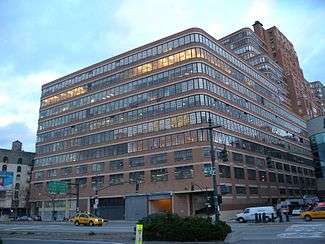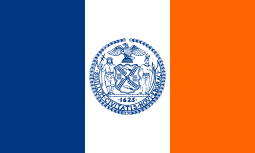Starrett-Lehigh Building
| Starrett-Lehigh Building | |
|---|---|
 | |
 Location within New York City | |
| General information | |
| Architectural style | International Style/Art Deco[1] |
| Location |
601 West 26th Street Manhattan, New York City United States |
| Coordinates | 40°45′06″N 74°00′24″W / 40.75167°N 74.00667°WCoordinates: 40°45′06″N 74°00′24″W / 40.75167°N 74.00667°W |
| Completed | 1931 |
| Cost | $6–9 million (est.)[1] |
| Owner | RXR Realty |
| Technical details | |
| Floor count | 19 |
| Design and construction | |
| Architect | Cory and Cory |
| Designated | October 7, 1986 |
The Starrett-Lehigh Building at 601 West 26th Street between Eleventh and Twelfth Avenues and between 26th and 27th Streets in Chelsea, Manhattan, New York City, is a full-block freight terminal, warehouse and office building. It was built in 1930–1 as a joint venture of the Starrett real-estate interests and the Lehigh Valley Railroad on a lot where the railroad had its previous freight terminal, and was designed by the firm of (Russell G.) Cory & (Walter M.) Cory, with Yasuo Matsui the associate architect and the firm of Purdy & Henderson the consulting engineers.[2][3]
Description
The building features large setbacks, polygonal corners, and alternating bands of steel strip windows, brickwork and concrete floorplates,[2][3] creating a striking effect described by architectural critic Lewis Mumford in 1931: "the contrast between the long, continuous red-brick bands and the green-framed windows, with sapphire reflections or depths, is as sound a use of color as one can see about the city."[4] The modernity of the building's design made it one of the few American structures not designed by a major architect cited in the 1932 "Modern Architecture: International Exhibition" show of the Museum of Modern Art,[2]<ref name=desrep /) – from whence derives the name of the International Style of architecture.[5]
Like the Terminal Warehouse Central Stores Building on the next block uptown, trains could be driven directly into the ground floor of the building, which included not only a rail yard, but also loading and unloading facilities for trucks, warehouse areas for storage, repackaging, redistribution, and manufacturing facilities as well as areas to display goods.[6] The office section is above the north facade.[3] The structural requirements for the building, which has 26 million cubic feet of space, 1.8 million square feet of which is rentable, necessitated innovative interior engineering.[1] During construction, the geology of the site forced a change from the original plan of a uniform 15-story building to the current layout of a 19-story section in the middle, flanked by 9-story wing on the west, and an eastern one of 18 stories.[1]
History
The building was completed in 1931 by the Starrett Corporation and the Lehigh Valley Railroad, on the site of a former freight terminal for the latter. When William A. Starrett died in 1932, the Lehigh Valley Railroad bought the building outright, but by 1933 it was a losing proposition, with a net loss that year of $300,000.[4] A number of factors contributed to the building not being an immediate financial success. The city's construction boom of the 1920s came to a stop with the start of the Great Depression and there was less demand for the rentable space in the building; the cost of construction was more than expected, due to changes in the foundation necessitated by differing level of bedrock across the building's footprint; and competition from another terminal with considerably cheaper rates announced to be built by the Port Authority – 111 Eighth Avenue, built in 1932 – depressed the buyer's market further, as they waited for the new building instead of renting from Starrett-Lehigh.[1] The Lehigh Valley Railroad disassociated itself from the building in 1944,[7] and the rail lines were removed in 1966.[4] By 1998, it was owned by the Helmsley real estate concern.[4]
The Starrett-Lehigh Building was named a New York City landmark in 1986,[1] and is part of the West Chelsea Historic District, designated in 2008.[7]
In April 2011, Shorenstein Properties of San Francisco, who owned the building, sold it to RXR Realty for $900 million.[8] Among the tenants in the building are Martha Stewart Living Omnimedia,[8] Diller Scofidio + Renfro, the Mcgarrybowen advertising agency, Club Monaco US of Ralph Lauren Corporation and Tommy Hilfiger USA, the building's largest tenant.[9] and Vanessa Deleon.
See also
 New York City portal
New York City portal Architecture portal
Architecture portal- International Style
References
Notes
- 1 2 3 4 5 6 "Starrett-Lehigh Building Designation Report" New York City Landmarks Preservation Commission (October 7, 1986)
- 1 2 3 New York City Landmarks Preservation Commission; Dolkart, Andrew S. (text); Postal, Matthew A. (text) (2009), Postal, Matthew A., ed., Guide to New York City Landmarks (4th ed.), New York: John Wiley & Sons, ISBN 978-0-470-28963-1, pp.71–72
- 1 2 3 White, Norval & Willensky, Elliot (2000), AIA Guide to New York City (4th ed.), New York: Three Rivers Press, ISBN 978-0-8129-3107-5, p.187
- 1 2 3 4 Gray, Christopher. "Streetscapes: Starrett-Lehigh Building; Time of Change for a Modern Industrial Landmark" New York Times (May 31, 1998)
- ↑ Harris, Bill (text); Brockmann, Jorg (photographs). Five Hundred Buildings of New York. New York: Black Dog & Leventhal, 2002. p.57. ISBN 978-1-57912-856-2
- ↑ Federal Writers' Project (1939), New York City Guide, New York: Random House, ISBN 0-403-02921-X (Reprinted by Scholarly Press, 1976; often referred to as WPA Guide to New York City), p.72
- 1 2 Brazee, Christopher D. and Most, Jennifer L. "West Chelsea Historic District Designatin Report". New York City Landmarks Preservation Commission (July 15, 2008)
- 1 2 Levy, Dan. "RXR Said to Buy NYC’s Starrett-Lehigh Building for $900 Million" Bloomberg Businessweek (April 20, 2011)
- ↑ Agovino, Theresa. "Ad agency adds 47K SF at Starrett-Lehigh" Crain's New York Business (January 10, 2012)
External links
 Media related to Starrett-Lehigh Building at Wikimedia Commons
Media related to Starrett-Lehigh Building at Wikimedia Commons